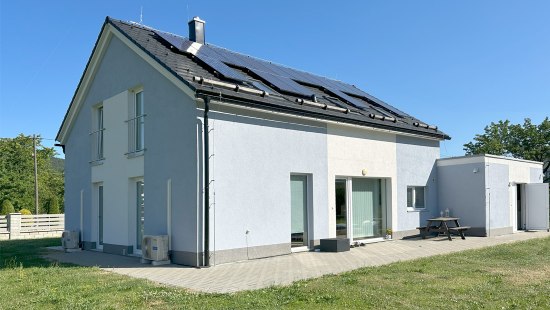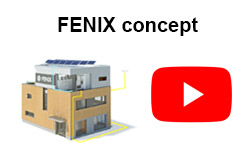Family house in Písečná near Jeseník

The newly built family house is located in the village of Písečná near the town of Jeseník. It is based on the shape of the original country houses typical for Jeseníky. The house is one-storey, without basement, medium size with a residential attic and an attached farm part.
The newly built family house is located in the village of Písečná near the town of Jeseník. It is based on the shape of the original country houses typical for Jeseníky. The house is one-storey, without basement, medium size with a residential attic and an attached farm part.
Heating and ventilation, water heating
In the family house, electric floor heating is installed with ECOFLOOR ADPSV heating cables, with a total input power of 9.6 kW, fixed to the thermal insulation in plastic T-sheets, allowing easy installation of heating circuits and poured concrete screed. For the floor, the users chose ceramic tiles and glued vinyl carpeting.
The bathrooms are equipped with two electric heating ladders – 300 and 400 W. The regulation of the entire heating system is provided by the BMR central control system, which allows the regulation of each room separately, including remote access via the Internet. In the living room, the Romotop LUGO fireplace is placed as a convenient additional source. According to the user, the wood consumption is about
1 m3/year.
Water heating is provided by an electric storage heater with a volume of 160 l, ventilation with heat recovery is provided by a WAFE 350 EFS wall-mounted heat recovery unit with electric reheating of the supply air.
In 2021, two additional air conditioning units were installed, used for cooling on hot summer days and also for zone heating in the transitional period before the heating season, before the outside temperatures drop to the values when the electric underfloor heating is switched on. In 2023, an outdoor swimming pool with water heating by a separate heat pump was installed. It is worth noting that although the building with more than 163 m2 of living space is equipped with electric heating and other extra equipment (air conditioning, swimming pool), the electricity consumption is relatively low.
Photovoltaic rooftop power plant with storage
At the outset, it should be noted that the PV power plant design was prepared in 2017 and the application was subsidised by the New Green Savings Programme. From today’s point of view, the installed PV plant is complicated and inefficient, but due to the subsidy it was not possible to retrofit the installation from the first stage. Therefore, the next stage continued in accordance with the solution chosen at the beginning.
In the first stage, a total of 15 PV panels (325 Wp/unit) were installed on the roof of the building, divided into two circuits, each circuit equipped with its own single-phase inverter. The first circuit has 7 PV panels and is connected directly to the L1 phase, without any accumulation. Therefore, appliances that can be targeted for use during the daily production of the PV plant – e.g. cooking appliances, washing machine, dryer - are concentrated in this phase. Unconsumed electricity flows back into the distribution network.
The second circuit containing 8 PV panels, connected to the L2 phase, is equipped with a battery storage of 7.2 kWh (3x 2.4 kW) and is preferably connected to the circuits for which a backup is desirable in case of an interruption in the grid supply. Excess generation is stored in batteries or flows back to the grid. Unfortunately, the installer has also connected an electric storage heater that could act as an energy storage device on the L1 phase to this backup circuit.
The third L3 phase was not interconnected with the PV plant until 2023 and was therefore also the least loaded with appliances. However, additional 8 PV panels (450 Wp/pc) with 7.1 kWh storage (2x 3.55 kWh) were installed and connected for this phase in summer 2023. Therefore, part of the appliances from the L1 and L2 phases were reconnected to L3 to take advantage of the PV expansion.
The total cost of the PV plant was approximately CZK 550 thousand, the first stage was subsidized with CZK 150 thousand, the second stage was without subsidy. The disadvantage of this solution is that the PV plant and storage on each phase are not connected in any way, so it can happen that even if the batteries on one phase are charged to 100%, the appliances on another phase consume electricity purchased from the grid.
Technical parameters
- Built-up area: 205,5 m2
- Usable area: 257,5 m2
- Heated area: 162,8m2
- Main house circuit breaker: 3x 25 A
- House rate: D57D
- Calculated heat loss: 5,4 kW
- Installed cable heating power: 10,3 kW
- Heat recovery: WAFE 350 EFS (80-350 m3/h; η = 86-97 %)
- Bivalent source: Romotop LUGO 5,9 kW wood-burning stove
- PV panels: 8,475 kWp (15 units + 8 units)
- Storage: Pylontech 14,3 kWh (7,2 + 7,1 kWh)
- Inverters: 3x 1f GOODWE
- PV plant cost: ≈ 550 tis Kč
- NGS subsidy: CZK 150 thousand
Balance of consumption
The following table shows the balance of energy consumption per calendar year. Except for 2020, which does not include the house consumption for January and most of February, the PV plant covers only 20–22% of the building annual consumption despite the batteries. On the other hand, more than 50% of the energy produced flows without benefit to the grid at minimum feed-in tariffs.
| Period | PV Plant | House Consuption Coverage | House Consuption | BILL * (incl. VAT) |
||
|---|---|---|---|---|---|---|
| Production | Overflow | PV plant | Distribution | |||
| 2020 (from 19 Feb) |
4 897 kW | 2 654 kW | 2 243 kW | 5 864 kW | 8 107 kW | CZK 20 015 |
| 54.2% | 27.7% | 72.3% | ||||
| 2021 | 4 852 kW | 2 591 kW | 2 261 kW | 9 291 kW | 11 552 kW | CZK 30 912 |
| 53.4% | 19.6% | 80.4% | ||||
| 2022 | 5 123 kW | 2 747 kW | 2 376 kW | 8 715 kW | 11 091 kW | CZK 28 019 |
| 53.6% | 21.4% | 78.6% | ||||
*The annual bill already includes the purchase of electricity from the PV plant
The detail of PV production and consumption of the house by month is clearly displayed in the graphs (see Downloads). The available data shows that the PV plant covers 21% of the energy consumed in the building on average, but more importantly, despite the battery storage, more than 50% of the energy produced overflows into the grid at a minimum feed-in tariff. Particularly in the summer months (May–August), the PV plant could often cover up to 100% of the house needs, yet about 60% of the energy produced flows to the grid at the minimum purchase price for the user to buy it back at full price.






